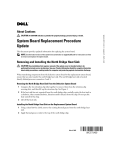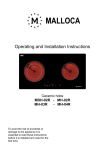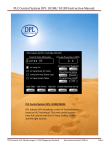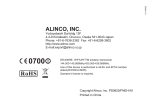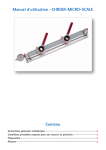Download Operating instructions A C F B H D K G E - m
Transcript
Operating instructions Preparation In order to keep the movement between the glass scale and the metal frame friction-free, the CHROM-MICRO-SCALE should be cleaned periodically on the bottom with cleaning alcohol and treated with talcum powder. Sticky materials should also be treated in the same manner. It is very important that the frame lays parallel to the plane to be measured. If the piece to be measured is shorter than the frame, the frame should be shimmed on the ends to the same thickness. Measuring with the Dial Indicator Position Dial Indicator A to locate against bracket C. Tighten lock-screw D. Caution: Over-tightening can cause the indicator to stick! Move the scale with the adjusting screw E to get mark B approx. in the middle of the range F. Line up the 0-line of the scale as close as possible with the first line a to be measured. Use left loupe to make corrections with the adjusting screw E to match the 2 lines exactly. Reset Dial Indicator A to «0» on the bezel. During measurement the adjusting screw E should be moved in the same direction each time (cw). In case the movement was too far please move back and start again turning cw. To measure the distance between a (left loupe) and b (right loupe) move the scale with the adjusting screw E (cw) until the line b lines up exactly with the next graduation line, as shown in our example 154.2mm. By reading the deviation on the black, metric graduation of the Dial Indicator A e.g. – 0.02mm, the actual distance a to b is the addition of the two readings, 154.18mm. Measurements in inches are performed in the same manner using the inch graduations on scale and indicator (red graduation). Illuminator The illuminators H are very helpful if there is not enough backlighting available. They fit into the base of the loupes. To switch on and off and to search for the best illumination turn the lamp Loupes The loupes feature 15x magnification and a field of view of Ø12mm. A red centering ring helps to avoid parallax errors. To focus the loupe simply turn the black ring. The loupes or rather the bases of the loupes can be easily moved on the scale or removed from it by pressing the red knob G. E a b 0 154 G distance a – b K A D C F B H f Reading error through parallax Graduation and line to be checked meet on the same plane: even in oblique view no parallax error. Graduation and line to be checked are apart from each other: on oblique view a parallax error will result. To avoid parallax errors each loupe is equipped with a red centering ring. Perpendicular viewing = ring concentric = no parallax error. Oblique viewing = ring eccentric = a parallax error may result. Light gap disappears Measuring of line thicknesses a) narrow lines Use the special measuring marks with the light-eliminating method («shaving» the left and right edge of the line). Proper offset-marking alignment: light gap dissapears Light gap disappears b) thick lines Use the scale divisions by aligning the edges of the line to be measured with the center of the graduation line («halved»). Measuring of distances a) aligning to the line to be measured by estimating symmetry Methods for correct alignment of different line thicknesses X b) without estimating symmetry through edge alignment of lines Alignment of left and/or right edges with the light-eliminating method. If line thicknesses are equal, dimension X (center to center of lines) equals dimension X1 (edge to edge of lines). X1 If line thicknesses are not equal, dimension X (center to center of lines) equals the average of the two dimension X1 (measurement left edges) and X2 (measurement right edges). X = (X1+X2)/2 X X2 Cleaning and maintenance Glass scale, metal frame, rubber pads and the adjusting screw E can be cleaned with cleaning alcohol whenever necessary. The adjusting screw should be lubricated with a drop of oil afterwards. Warning: to not oil any other parts of the scale or the Dial Indicator!



